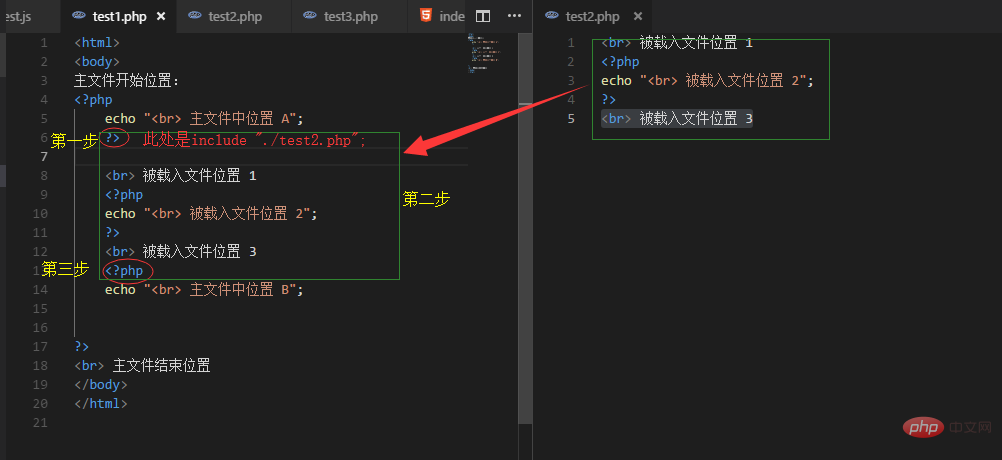Rumah >pembangunan bahagian belakang >masalah PHP >php引用文件有几种方式
php引用文件有几种方式
- 青灯夜游asal
- 2021-05-12 17:50:366810semak imbas
php引用文件有4种方式:1、使用include()函数,可以放在PHP脚本的任意位置;2、require()函数,一般放在PHP脚本的最前面;3、include_once()函数;4、require_once()函数。

本教程操作环境:windows7系统、PHP7.1版,DELL G3电脑
PHP中有四个加载文件的语句:include、require、include_once、require_once。
基本语法
require:require函数一般放在PHP脚本的最前面,PHP执行前就会先读入require指定引入的文件,包含并尝试执行引入的脚本文件。require的工作方式是提高PHP的执行效率,当它在同一个网页中解释过一次后,第二次便不会解释。但同样的,正因为它不会重复解释引入文件,所以当PHP中使用循环或条件语句来引入文件时,需要用到include。
include:可以放在PHP脚本的任意位置,一般放在流程控制的处理部分中。当PHP脚本执行到include指定引入的文件时,才将它包含并尝试执行。这种方式可以把程序执行时的流程进行简单化。当第二次遇到相同文件时,PHP还是会重新解释一次,include相对于require的执行效率下降很多,同时在引入文件中包含用户自定义函数时,PHP在解释过程中会发生函数重复定义问题。
require_once / include_once:分别与require / include作用相同,不同的是他们在执行到时会先检查目标内容是不是在之前已经导入过,如果导入过了,那么便不会再次重复引入其同样的内容。
相互区别
include和require:
include有返回值,而require没有返回值
include在加载文件失败时,会生成一个警告(E_WARNING),在错误发生后脚本继续执行。所以include用在希望继续执行并向用户输出结果时。
//test1.php
<?php
include './tsest.php';
echo 'this is test1';
?>
//test2.php
<?php
echo 'this is test2\n';
function test() {
echo 'this is test\n';
}
?>
//结果:
this is test1
require在加载失败时会生成一个致命错误(E_COMPILE_ERROR),在错误发生后脚本停止执行。一般用在后续代码依赖于载入的文件的时候。
//test1.php
<?php
require './tsest.php';
echo 'this is test1';
?>
//test2.php
<?php
echo 'this is test2\n';
function test() {
echo 'this is test\n';
}
?>结果:
include和include_once:
include载入的文件不会判断是否重复,只要有include语句,就会载入一次(即使可能出现重复载入)。而include_once载入文件时会有内部判断机制判断前面代码是否已经载入过。这里需要注意的是include_once是根据前面有无引入相同路径的文件为判断的,而不是根据文件中的内容(即两个待引入的文件内容相同,使用include_once还是会引入两个)。
//test1.php <?php include './test2.php'; echo 'this is test1'; include './test2.php'; ?> //test2.php <?php echo 'this is test2'; ?> //结果: this is test2this is test1this is test2 //test1.php <?php include './test2.php'; echo 'this is test1'; include_once './test2.php'; ?> //test2.php <?php echo 'this is test2'; ?> //结果: this is test2this is test1 //test1.php <?php include_once './test2.php'; echo 'this is test1'; include './test2.php'; ?> //test2.php <?php echo 'this is test2'; ?> //结果: this is test2this is test1this is test2 //test1.php <?php include_once './test2.php'; echo 'this is test1'; include_once './test2.php'; ?> //test2.php <?php echo 'this is test2'; ?> //结果: this is test2this is test1
require和require_once:同include和include_once的区别相同。
载入时执行过程
1. 从include(require)语句退出php脚本模式(进入html代码模式)
2. 载入include语句所设定的文件中的代码,并尝试执行
3. 退出html模式,重新进入php脚本模式,继续后面脚本程序的执行
//test1.php 100db36a723c770d327fc0aef2ce13b1 6c04bd5ca3fcae76e30b72ad730ca86d 主文件开始位置: d1127986a510a0769ea97e41aaf6d64b 主文件中位置 A"; include "./test2.php"; //要载入的文件 echo "0c6dc11e160d3b678d68754cc175188a 主文件中位置 B"; ?> 0c6dc11e160d3b678d68754cc175188a 主文件结束位置 36cc49f0c466276486e50c850b7e4956 73a6ac4ed44ffec12cee46588e518a5e //test2.php 0c6dc11e160d3b678d68754cc175188a 被载入文件位置 1 <?php echo "0c6dc11e160d3b678d68754cc175188a 被载入文件位置 2"; ?> 0c6dc11e160d3b678d68754cc175188a 被载入文件位置 3
结果:
分析:
返回值的比较
上文说道include有返回值,而require无返回值
对于include,如果载入成功,有返回值,返回值为1;如果载入失败,则返回false.
对于require,如果载入成功,有返回值,返回值为1;如果载入失败,无返回值。
//test1.php <?php $a = include "./test2.php"; var_dump($a); echo "<br>"; $b = include "./test2.phps"; var_dump($b); echo "<br>"; $c = require "./test2.php"; var_dump($c); echo "<br>"; $d = require "./test2.phps"; var_dump($d); ?>
输出:

当文件中有return:
当被载入文件中有return语句时,会有另外的机制,此时return语句的作用是终止载入过程,即被载入文件中return语句的后续代码不再载入。return语句也可以用于被载入文件载入时返回一个数据。
//test1.php <?php $a = include "./test2.php"; echo "<br>"; var_dump($a); ?> //test2.php //该文件中有return语句 <?php $b = 'test2'; echo "被载入的文件:A 位置"; return $b; echo "<br 被载入的文件: B 位置"; ?>
结果:

推荐学习:《PHP视频教程》
Atas ialah kandungan terperinci php引用文件有几种方式. Untuk maklumat lanjut, sila ikut artikel berkaitan lain di laman web China PHP!




